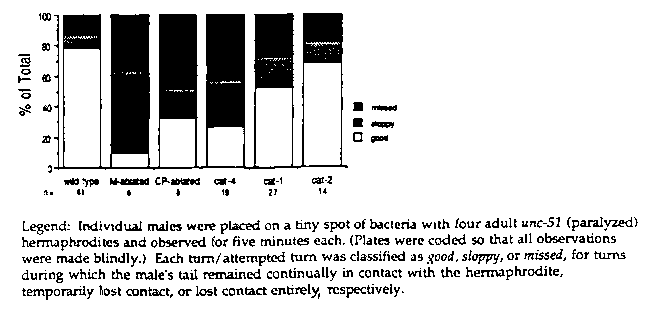Worm Breeder's Gazette 12(2): 80 (January 1, 1992)
These abstracts should not be cited in bibliographies. Material contained herein should be treated as personal communication and should be cited as such only with the consent of the author.
Serotonin antisera stain some neurons specific to the male in C. elegans (The Worm Book, p.377-8). Among these are six cells in the ventral nerve cord that have been tentatively identified as the CP motoneurons derived from P(38).a (G. Garriga, personal communication). These neurons, along with the pair of NSM neurons in the pharynx, are the brightest, most reliably staining serotonin-immunoreactive cells in the worm. EM reconstructions show that CP neurons have neuromuscular junctions with male-specific diagonal muscles, suggesting they may play a role in male mating behavior (The Worm Book, p.121).
Mating behavior of the adult male is among the most complex behaviors exhibited by C. elegans. The behavior can be divided into at least five components: recognition, backing, tail curling, vulval location, and copulation (including spicule insertion and sperm transfer); candidate neurons involved in many aspects of this behavior have been identified by ablation (Sulston, WBG 7(2): 22; Liu and Sternberg, Soc. Neurosci. Abstr. 17: 549). When an adult male contacts an hermaphrodite with his tail, he immediately backs along the surface of the hermaphrodite, pressing his tail firmly to the hermaphrodite. When he reaches the end of his intended mate, he makes a tight ventral curl to place his tail in contact with the opposite surface. The male then continues moving his tail along that surface in search of the vulval opening. This behavior may be repeated many times before the vulva is located and copulation is initiated.
Application of serotonin to male worms is known to result in a tight ventral curling of the tail (see below), reminiscent of turning exhibited during mating behavior.
[See Figure 1]
To investigate the role of the CP motoneurons and serotonin in male mating, we assayed the tail curling/turning ability of individual males following ablations or in males containing mutations that alter serotonin expression. Ablation of the mesoblast M eliminates the diagonal muscles of the male, the postsynaptic target of the CP motoneurons. In M-ablated males, application of serotonin no longer caused a tight ventral curling of the tail, although the posterior body was slightly curled ventrally. These males were severely deficient in turning behavior. Ablation of the immediate precursors of CP's (P3-8.aap) also resulted in males that were deficient in turning, although they were not as severely affected as M-ablated males (see graph below). We have also confirmed that the serotonin-containing ventral cord neurons are derived from P(3-8).aap by ablation for example, when P3 .aapand P4 .aapwere ablated and the male subsequently stained with anti-serotonin, the two most anterior cell bodies were missing.
We wondered whether worms with altered serotonin expression would show similar defects. cat-4 mutants lack anti-serotonin staining; cat-1 worms have variably decreased serotonin staining (Desai et al, 1988, Nature 336: 638). cat-1 and cat-1 males display decreased mating efficiency (Hodgkin,1983, Genetics 103: 43). cat-4 males were similar to CP-ablated males in their poor turning ability; cat-1 males were variably deficient in turning (see graph below). The mutant ad446 (courtesy of G. Garriga) also lacks serotonin and appears to be similarly defective. Since cat-4 and cat-1 are also deficient in dopamine expression (Sulston et al., 1975, J. Comp. Neurol. 163: 215), we also scored the turning ability of cat-2 mutants, which are dopamine deficient, but wild type for serotonin. These males were only slightly poorer than wild type in turning ability. Although most of the turning defect in cat-4 males may be accounted for by defective CP's, there may also be a sensory deficit at least two ray neurons are stained by serotonin antisera in wild type.
Thus, ablation of CP's or reduction of serotonin results in a specific behavioral deficit in male mating behavior. We plan to screen for mutants in turning behavior to obtain additional serotonin-deficient mutations. Mutations that cause loss of serotonin expression may alter genes needed for serotonin synthesis or genes that regulate their expression; these may provide us a handle to understanding the regulation of the serotonergic phenotype.
[See Figures 1-4]


